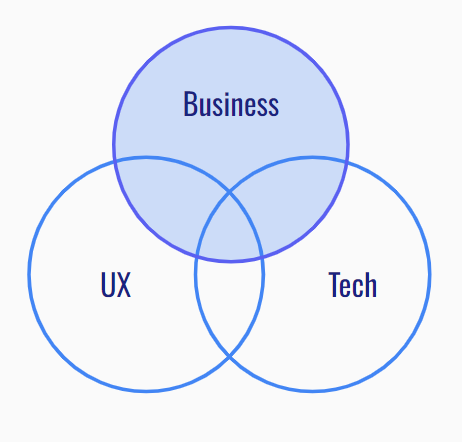King of the Mountain, er, Middle
In product management, there’s a classic image that almost everyone in tech knows: the Venn diagram where the product manager (PM) sits squarely at the center, intersecting the spheres of users, technology, and business.  This graphic has been revered, debated, and reshared countless times, and it’s not hard to see why—it simplifies a complex role into a neat visual. But guess what: it’s not just PMs who believe they belong at that nexus. Interaction designers, information architects, and UX designers often see that central spot as their rightful place too.
This graphic has been revered, debated, and reshared countless times, and it’s not hard to see why—it simplifies a complex role into a neat visual. But guess what: it’s not just PMs who believe they belong at that nexus. Interaction designers, information architects, and UX designers often see that central spot as their rightful place too.

So, who really deserves to be in the middle?
The PM role is often described as the mini-CEO for the product. They are the ones tasked with aligning everyone’s efforts toward the business goals. It’s their job to make sure that every feature, fix, and functionality not only makes sense for the users but also aligns perfectly with the strategic objectives of the business. In this light, you might say the PM owns the business domain in a way no one else on the team does.

The best PMs aren’t those who commandeer every decision. PMs must recognize and respect the unique skills and expertise each team member brings to the table. And yes, that means both understanding when to step back and let the designers or programmers lead the way in their respective areas AND realizing that these folks may have great business insights.
Here’s how I see it playing out in the real world: the PM is in charge of the business outcomes. They need to make sure the product not only delights our users but also hits the financial targets, scales appropriately, and fits within the broader market strategy. That’s a tall order, and it involves a lot more than just being a go-between among different departments.
Now, while the PM oversees the business, UX designers and other related roles dive deep into the user experience aspect. They’re the ones obsessing over every pixel on the screen, ensuring the product isn’t just functional but also intuitive and enjoyable to use. Their mastery over user understanding and design thinking is critical, and it’s something the best PMs not only appreciate but rely on heavily.
A programmer bridges the gap between product managements’ vision and UX design’s aspirational needs. Sure, they translate planned features and user requirements into functional software. But they are just as creative as the other two roles, and from that experience and creativity can come ideas the other two would have never imagined. Their role is crucial in ensuring the product is feasible, optimized, and successful.
This is what Teresa Torres refers to as “The Product Trio.”
“A product trio is jointly responsible for a shared outcome. They interview customers together. They map out the opportunity space together. They choose a target opportunity together. They generate solutions together. And they iteratively test and develop those solutions together.”
They work collaboratively from beginning to end, iterating their way to their desired outcome.

In my experience, a PM who understands the value of their partners will ensure that user insights and technical feasibility inform product decisions. As well, the UX team and tech teams need to grasp the business context to tailor their work effectively. This mutual respect and understanding help in carving out a product that’s not only beautiful but also commercially viable.
So, who belongs in the middle of the Venn diagram? In theory, everyone, because a product is more than the sum of its parts. It’s the result of collaboration—intense, messy, and often challenging collaboration. At the end of the day, it’s the PM’s responsibility to channel these diverse efforts towards the business goals.

Remember, the best PMs work closely with design and engineering but maintain a keen awareness of everyone’s unique contributions. They lead, they listen, and they leverage the collective strengths of their team to push the product beyond ordinary boundaries.


